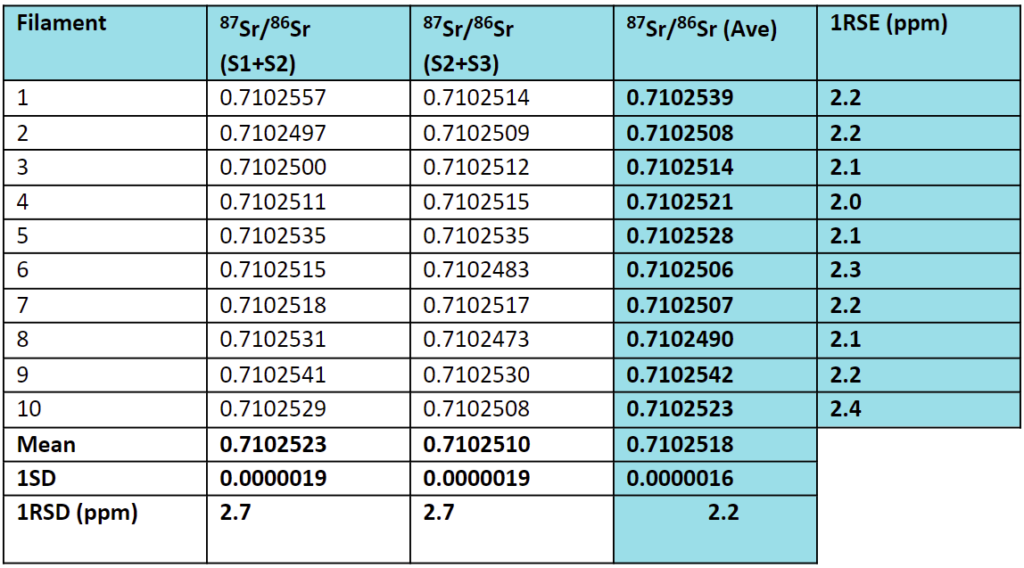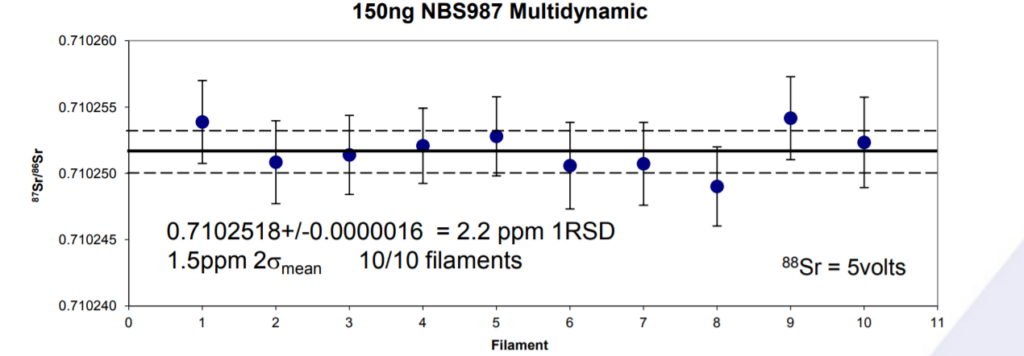Introduction
Very high precision Strontium isotope ratio measurements are particularly important in some geochronological applications. For example, variations as small as 0.00001 in 87Sr/86Sr are significant in high resolution dating of marine carbonates. (e.g. McArthur JM, Howarth RJ, Bailey TR. 2001.).
In order to test the capabilities of the Phoenix Thermal Ionisation Mass Spectrometer to accurately measure 87Sr/86Sr ratios, replicate measurements of the Strontium standard NBS 987 were made. 150ng of NBS 987 was loaded onto degassed Re filaments with a TaF activator and data was acquired using multidynamic mode.
Multidynamic Mode
During a multidynamic acquisition, the mass spectrometer cycles through a series of static measurements, each using a slightly different collector configuration. Table 1 shows the collector configuration that was used here. Note that by the end of the acquisition, ratios have effectively been collected in both multi-collector and single collector mode. This allows the data to be corrected for variations in beam intensity as well as for differences in collector and amplifier response. Hence multidynamic acquisition is superior to amplifier averaging which takes no account of variations in collector response.
For these reasons multidynamic mode is the ‘gold standard’ for acquisitions involving long collection cycles where data of the highest possible precision and accuracy is required.
A multidynamic acquisition is also a test of a mass spectrometers optics and its ability to peak-jump very accurately.
Also, the gain resistors must be able to respond rapidly to changes in beam intensity. On Phoenix, the signal decay (Tau) is better than 5ppm of the initial intensity within two seconds. For example for a 5e-11A beam of 88Sr, the signal decays to 2.5e-16A in two seconds.

Analytical Protocol
All analyses were performed completely automatically without operator intervention. The ion beam was optimised to produce a 88Sr ion intensity of 5 volts (5e-11amps). The analysis comprised 25 blocks, each consisting of 20 cycles of data. Each cycle consisted of three static 10 second integrations. Baselines were measured for 40 seconds at the beginning of each block of data.
Measurements were made in three sequences. Firstly, a measurement was made on the collectors shown in sequence 1. A peak jump was then performed and the measurement repeated on the collectors shown in sequence 2 before a second peak jump moves the ion beams onto the collectors shown in sequence 3. The cycle was then repeated multiple times.
Finally, the data system applies a simple mathematical algorithm which cancels out variations in collector/ amplifier response and performs an exponential fractionation correction. Separate calculations are made for sequence 1 corrected against sequence 2, then sequence 2 against 3. This gives two values which are averaged to give the reported value . Dickin, A, 2005, provides more details on multidynamic data collection.
Results
The results are shown in Table 2. The 87Sr/86Sr calculated from sequence 1/2 and sequence 2/3 are the same within the reproducibility of the measurement. The mean value of the combined collector pairs is 0.7102518+/-0.0000016 which is a relative standard deviation of 2.2ppm. This is the same as the individual measurement precisions, and indicates that there are no influences from instrumental or sample focussing effects.


Summary
2ppm 87Sr/86Sr reproducibility has been obtained on 150ng of Strontium with 5 volt 88Sr ion beams using a multidynamic analysis method.
References
McArthur JM, Howarth RJ, Bailey TR. 2001.) Strontium Isotope Stratigraphy: LOWESS Version 3: Best fit to the marine Sr-Isotope Curve for 0-509 Ma and accompanying look-up table for deriving numerical age. Journal of Geology. 109: 155-170
Dickin AP, Radiogenic Isotope Geology, Cambridge University Press, 2005.
Download Application Note
Download the complete Application Note: High Precision Sr on Phoenix